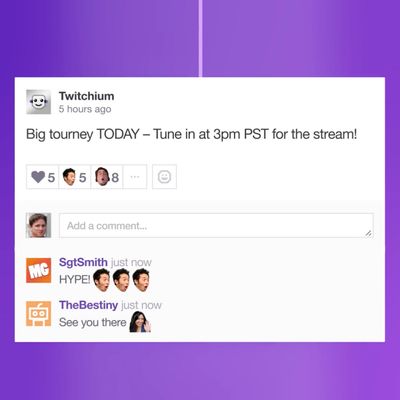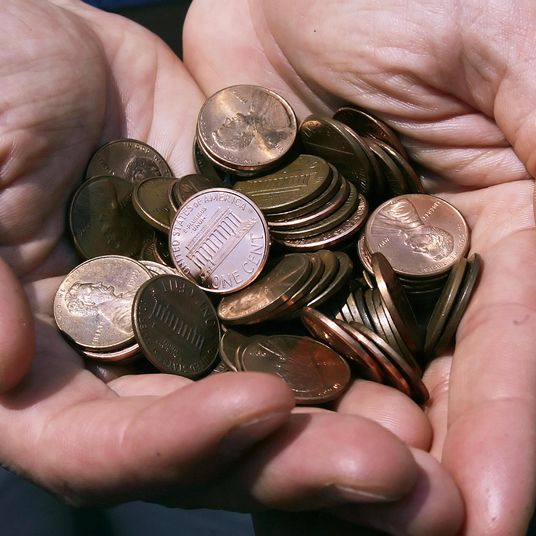
On Monday, the Verge reported that Twitch, the live-streaming video-game website, would be “launching a Twitter competitor.” That competitor is Pulse — an updating feed that collects photos, images, and text from Twitch users. “If Twitter were ever going to be disrupted,” the Verge’s Casey Newton wrote, “this is exactly what I’d imagine it would look like.” But casting Twitch in the mold of a media-favorite app like Twitter is a mistake. Twitch doesn’t seem to want to be the new Twitter, and more importantly, it doesn’t need to be.
Twitch, if you didn’t already know, is a live-streaming service devoted exclusively to video games. Put bluntly: It’s a website where you watch people (streamers) play video games live. These videos can best be divided into two categories: “let’s play,” the genre where people play and react to video games, while giving a running commentary (think: PewDiePie); and eSports, which are broadcast tournaments — usually with commentators — along the lines of, well, normal sports.
If you’re not a gamer, or steeped in internet culture, it can be hard to understand what the attraction of Twitch is: You just watch people play games? If you don’t get it, there’s probably no satisfying answer or explanation. For many gamers, though, the site is a gravitational center for their hobby: It’s a place to interact with fellow hobbyists; to learn more about games before you buy them; to study the best in the business, so you can improve your own skills; and to enjoy watching highly skilled players compete against one another.
It’s also a way to make money. For a small subset of Twitch streamers who are dedicated (and good) enough, the site can become a significant source of revenue. The service allows users to run pre- and mid-roll ads on their channels, as well as offer subscriptions for $5 a month. Subscribing might get fans access to special chat rooms or emoticons. Twitch also popularized the concept of a virtual tip jar — sending payments of a buck or two (or way more) via services like PayPal and Venmo, if you like what a streamer does. The site alone isn’t minting millionaires yet, but it’s demonstrating a possible path to being a “professional gamer” outside the world of competitive eSports, and in the process, is helping create a new category of professional entertainer: the streamer.
The thing that bears repeating is that Twitch is huge — even though you might not have heard of it, and the concept holds no appeal to you. The service was originally a gaming-centric spinoff of live-streaming site Justin.TV; it quickly outgrew its parent, and was eventually bought by Amazon in 2014 for $1 billion. It was a smart purchase. Where much-hyped live video has faltered for Facebook and Twitter, it thrives on Twitch, where viewers gather in the chat to yell, cheer, or emote in all caps for their favorite streamers. It’s also a platform with a built-in revenue model for its creators, which has incentivized people to try it out and create more content. It’s also a great way for Amazon to get people to buy video games.
Given all this, how are we to understand Pulse? It broadens Twitch by keeping users and streamers active, even while they aren’t actively participating in a broadcast. They can post status updates and highlight clips, and talk smack.
One crucial question is whether Twitch’s user base even wants that type of experience. Even popular Twitch streamers rarely have a substantial online presence elsewhere; their followings elsewhere (even if large) are a fraction of what they have on Twitch, indicating that viewers don’t often follow streamers from platform to platform. The dialogue between presenter and audience happens mostly during a broadcast, and in the comments section. The biggest threat that Pulse poses isn’t to social networks, but to other gamer-centric platforms — like chat service Discord, which allows anyone to set up a server and talk to their friends or followers, or gaming subreddits that often spawn threads off of Twitch highlights. If Pulse can relocate those conversations and highlight reels back onto Twitch, that means more money, and quicker growth.
It’s possible that Pulse is an attempt to expand beyond gaming; the site already has sections dedicated to streamers making art, or participating in the Korean tradition of mukbang (eating in front of a webcam). But Twitch’s offerings have never strayed far from its gamer audience, which is overwhelmingly young, willing to empty their wallets for the hobby they love, and almost always connected to the web in some fashion throughout the day. Twitch’s success exists in what feels like a bizarro web, one in which a social network becomes huge not from broadening itself to scoop up as many users as possible, but by honing in on the features and power users that drive interaction.
In that sense, the question of whether Pulse will supplant Twitter is almost beside the point. Twitch has grown into a successful company almost entirely outside of what we consider mainstream social media (e.g., anything your grandma might recognize). It’s for an extremely large but specific group — gamers — and exists within a discreet social and financial ecosystem, one that’s only now starting to trickle out into crowdfunded subscription services like Patreon. Twitter is well-known, and a media favorite — but Twitch has an enormous, devoted audience; multiple revenue streams; and a working video-advertisement model. Twitch doesn’t really need to learn anything from Twitter, because in many ways, it’s already surpassed it.





























